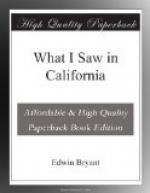“Cape St. Lucas, the southern extremity of the peninsula of Lower California, is in lat. 22 deg. 45’ N., has a bay that affords a good harbour and anchorage, perfectly safe nine months in the year; but it is open to the eastward, and the hurricanes which sometimes occur during July, August, and September, blow the strongest from the southeast, so that vessels will not venture in the bay during the hurricane season. I have landed twice at the Cape in a small boat, and I think a breakwater can be built, at small cost, so as to make a safe harbour at all seasons. Stone can be obtained with great ease from three cones of rocks rising from the sea, and forming the extreme southerly point of the Cape, called the Frayles. Looking to the future trade and commerce of the Pacific Ocean, this great headland must become a most important point as a depot for coal and merchandise, and a most convenient location for vessels trading on that coast to get their supplies. Mr. Ritchie, now residing there, supplies a large number of whale-ships that cruise off the Cape, annually, with fresh provisions, fruits, and water. The supplies are drawn from the valley of San Jose twenty miles north of the Cape, as the land in its immediate vicinity is mountainous and sterile; but the valley of San Jose is extensive and well cultivated, producing the greatest variety of vegetables and fruits. The sweet and Irish potato, tomato, cabbage, lettuce, beans, peas, beets, and carrots are the vegetables; oranges, lemons, bananas, plantains, figs, dates, grapes, pomegranates, and olives are its fruits. Good beef and mutton are cheap. A large amount of sugar-cane is grown, from which is made panoche, a favourite sugar with the natives; it is the syrup from the cane boiled down, and run into cakes of a pound weight, and in appearance is like our maple-sugar.
“Panoche, cheese, olives, raisins, dried figs, and dates, put up in ceroons of hide, with the great staples of the Californians—hides and tallow—make the export of San Jose, which is carried to San Blas and Mazatlan, on the opposite coast. This commerce the presence of the Cyane interrupted, finding and capturing in the Bay of La Paz, just after the receipt of the news of war on that coast in September, 1846, sixteen small craft, laid up during the stormy season, engaged in this trade.
“I cannot dismiss the valley of San Jose, from which the crew of the Cyane have drawn so many luxuries, without alluding to the never-failing stream of excellent water that runs through it (to which it owes its productiveness) and empties into the Gulf here, and is easily obtained for shipping when the surf is low. It is now frequented by some of our whale ships, and European vessels bound to Mazatlan with cargoes usually stop here to get instructions from their consignees before appearing off the port; but vessels do not anchor during the three hurricane months. The view from seaward, up this valley, is beautiful indeed, being surrounded




